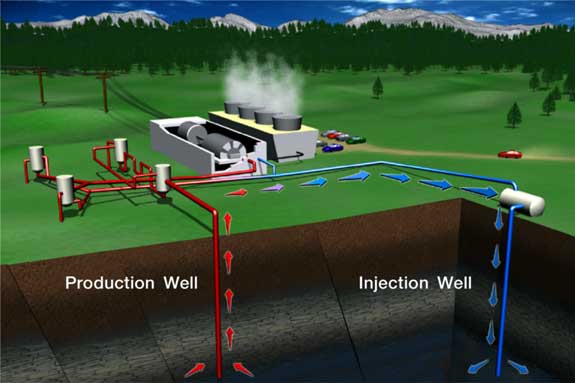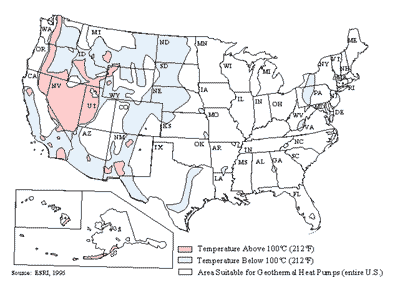That’s right, geothermal resources (hot fluid and/or gas) can and is being used to generate electricity the world over. Geothermal literally means “heat from the earth.” The first successful geothermal electricity generation installation was in Larderello, Italy in 1904. The largest is the Geysers in Northern California where 21 plants generate around 3% of California’s electricity.
Geothermal resources can also be used for heating, cooling, and industrial pursuits by circulating the resource through chillers, heat exchangers, etc. This type of use mitigates the need to spend so much other energy in those processes and allows for the use of temperate (<75C) geothermal fluids. Beneath the crust of the earth is a large convection circulated body of magma. In weaker and thinner areas of the earth's crust (typically faults) heat from the magma in the mantle is transferred to rocks in the crust and then in turn to water in proximity to the rocks which creates the geothermal resources.

When generating power from geothermal resources, the resource needs to be rather hot >110C. There are 3 methods of tapping the resource: direct dry steam (rare,) direct flash steam (more common,) and binary (increasingly common.) Dry steam is used where the geothermal resources are extremely hot transforming the liquid in the geothermal well directly to gas which then is directed through a separation process to weed out non-steam (rocks, minerals) then routed into a turbine which generates power. The steam is then cooled back into liquid form and then typically reinjected into the geothermal field through an injection well.
Flash steam also requires a very hot resource, though cooler than dry steam, which follows the same process generally as dry steam with an extra step of routing the resource from the production well into a lower pressure area which allows the super-heated liquid to “flash” into steam (this may be repeated a series of times to gather the most steam possible at different pressures) before the resource is cooled and reinjected into the geothermal field.
Perhaps the most interesting and useful of the conversion technologies is the binary plant which uses a series of heat exchangers to transfer the geothermal fluid’s heat energy to a working fluid in a closed system. Typically, the working fluid has a boiling point that is less than that of water (~75C) which is then converted to steam and run through the turbine system, cooled, and recirculated through the system. In this way, the geothermal resource is never in direct contact with the turbine which extends the lifetime and reduces the maintenance associated with the system. The lower operating temperature makes a number of geothermal resources feasible that wouldn’t work with either dry or flash steam approaches.
NREL estimates that with current technology there is around 80GW of geothermal production potential in the US alone. Currently, 2.2GW is in production, primarily in California, Nevada, Utah, and Hawaii.

Another promising, though early development technology is called “hot dry rock” which is being pioneered in Australia. The theory here is to find an area of heat exchange in the crust that lacks water, boring into it, then injecting water to create a man-made geothermal resource.
Properly managed, geothermal is the most cost effective, least polluting, and most predictable of all the renewable energy sources. Disadvantages of the geothermal approach are primarily cost related, it costs around $2.5M/MW at scale to locate an appropriate site, establish the infrastructure, connect to the grid, and begin operations. But the advantages are truly amazing, virtually no emissions from the technology, 90% capacity factor, saleable by products from the dissolved solids (typically silica and zinc,) relatively small plants, and very predictable output. Areas like the Geysers have seen reduced production as the geothermal resource has been removed at a rate greater than natural (and later human assisted) replenishment. That’s where proper resource management comes into play.
Of all the renewable technologies, geothermal has the best chance to compete at scale with traditional fossil fuel plants on the basis of cost, predictability, and reliability.
15 days to OSU/Michigan
Ohio State’s 2006 record: 9-0 Next up: at Illinois 11/4
Tune: Fools in Love by Inara George
Technorati Tags: Energy | Geothermal | Electricity | Mike Harding Blog
« Penny powered LED
» OSU survives against Illini, 17-10
Energy
Electricity from hot water
11.03.06 | 8 Comments
8 Comments
« Penny powered LED
» OSU survives against Illini, 17-10










[…] Another good article from Mike’s very informative and interesting blog, this one is about generating electriicity from geothermal energy. Electricity from hot water […]
Enjoyed looking at your blog. I’m specifically interested in renewable energy. The combination of your article “electricity from water”, and your question about what is renewable energy, has spurred me to make a response.
Geothermal energy is one of the least talked about, but most promising sources to relieve our energy shortage. Geothermal plants are the most environmentally responsible, and green energy sources, that one can find.
The source of this is virtually unlimited. As your article acknowledges geothermal energy is drawn from the heat of the earth. Our entire habitable world consists of several miles of and rock, soil, and water floating over a vast globe of molten lava. And that heat will constantly be be renewed until someone cancels the law of gravity.
With just the minimal amount of geothermal plants, that have been put into action so far, they already produce more electricity than all of the solar and wind plants combined.
Interesting, thanks for the comments Bill. I agree, geothermal energy is a very promising and underutilized renewable resource.
Can we use hot water (made hot by using solar water heater system)to produce electricity?
regards
Hi Anurag,
It depends. Solar Thermal is being used to generate electricity, but normally the heat concentrated on a working fluid filled vessel to attain very high temperatures >250 C which then drives turbines. This is cost effective at a utility scale presently so if you’re thinking about that, then yes. If it’s a smaller installation then the economics may not be favorable.
Good luck!
How cool, nya!
(^-^)
Let’s use it?
It sounds good, can we make electricity using solar heat absorbed from asphalt pavements?
I have a house heated by a closed loop lake source heat pump. With hydro rates climbing I wonder if using batteries and DC to AC converter to supply power to supply power to the pumps and heat pump. I also have a solar hot water system in this res. The question remains how do I charge the batteries? Solar? How can I convert solar hot water to electrical energy an economical venture.
I appreciate any possible assistance.
Bob